This page explores what the Earth and caring for it can mean, on a farmland. It then uses our Black Box woodland on our farm to describe some of the biodiversity that can be found, and provides some activities to learn about this.
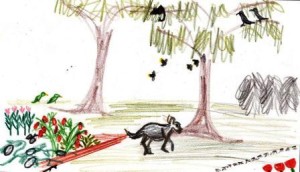 What does ‘the Earth‘ mean on a farm?
What does ‘the Earth‘ mean on a farm?
Not just the paddocks! Think about the farm gardens. What makes up ‘the Earth’ in my drawing of our garden? Some living things in our backyard – and the soil, water and air. Together they make up the ‘Earth’ of our farm, or any place, – its environment.
Lots of plants and creatures live on farms – from the very tiny to very large in size. Some are native, others domestic, some useful, and some weeds and pests.
The ‘Earth’ has lots of bits on a farm we can care for!
What does ‘caring for the Earth‘ mean?
No part of the farm operates alone. It is about a whole enviroment. Farmers care for their environment so it can keep making food and fibre, long into the future- that’s the basic idea of sustainability.
Our biggest challenge is when droughts occur.
Discover some stories about problems with dry times on farms written by farm children at St Joseph’s PS Hopetoun, in the pdfs ‘One Summer’ and “Water that saves’ under the Wimmera HUB-SPP in 2012.
 Keeping a place good for living things to continue to live there is one way of caring for native plants and creatures of a patch of Earth. This is another part of sustainability. It is part of the idea of ‘living in harmony with Nature‘ – the aim of the United Nations Decade of Biodiversity 2011-2020.
Keeping a place good for living things to continue to live there is one way of caring for native plants and creatures of a patch of Earth. This is another part of sustainability. It is part of the idea of ‘living in harmony with Nature‘ – the aim of the United Nations Decade of Biodiversity 2011-2020.
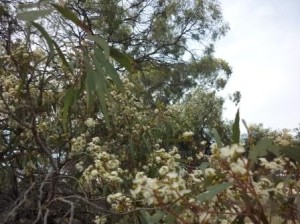 In a Black Box Woodland
In a Black Box Woodland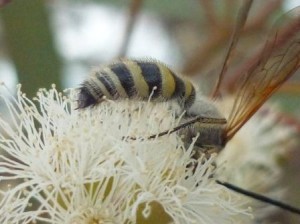
Part of our farmland is on Black Box Woodland – the old trees in the photos. Black Boxes are good ‘honey’ trees. They attract bees. Bees pollinate flowers, so they will grow more – vegies, fruits, crops, and garden flowers.
(Discover how to recognise this great tree from Black Boxes.)
Native living things of a Black Box Woodland on our farm are: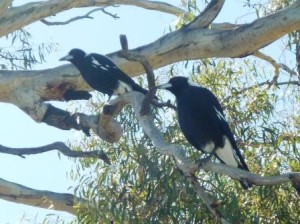
- insects (like Dragonflies, ants),
- birds (like Magpies, Kookaburras, Green Grass Parrots),

- mammals (like the possums), and monotremes (like echidnas)
- reptiles (like Skinks and Goannas),
- amphibians (like Mallee Spadefoots )
- grasses and herbs (like Chocolate Nodding Lillies),
- bushes (like Ruby Saltbush)
- ground cover (like Pig Face)
- and trees (like Black Boxes and Yellow Gums) .
Photos to the right show Magpies in the Yellow Gum, Echinda climbing over Black Box dropped branch, 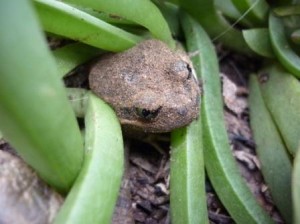 and Mallee Spadefoot frog in the Pig Face, and far below right, Goanna climbing up Yellow Gum.
and Mallee Spadefoot frog in the Pig Face, and far below right, Goanna climbing up Yellow Gum.
There may also be introduced living things :
- insects (like European Honey Bees – which we need to pollinate our European-based food crops)
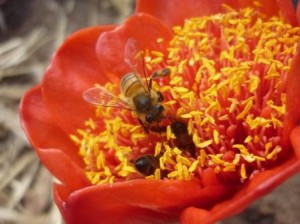
- animals (like the dog) and pests (like rabbits)
- plants (like flowers), and weeds (like Capeweed).
Photo to the right shows European Honey Bees in South African Cape Tulip.
Activities:
- Visit my European Honey Bees page to see photos of bees drinking and what they did to get that water in extreme heat.
- Take the challenge to name the mystery weed in “What Weed is that2?” at weeds )
- Discover some of the problems with weeds and pests on farms in stories written by farm children at St Joseph’s PS Hopetoun, in the pdfs ‘Four Farming Brothers’, ‘Bats’, ‘Pesty Solutions’ and ‘Saving the Barley’ under the Wimmera HUB-SPP 2012.
Some ways we ‘care for the Earth’

- soils – leaving stubble on the land after harvest and having a stock containment area.
- water – thoughtful use as it now mostly comes from the Grampians via the Wimmera-Mallee pipeline.
- trees – keeping the old ones and
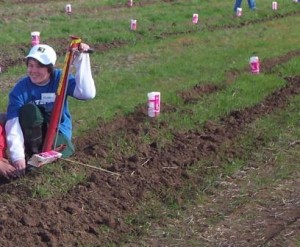 planting new ones to:
planting new ones to: - store carbon,
- take CO2 from the air and put O2 back into it.
- have hollows birds like Kookaburras and the Barn Owl to nest in,
- and bark for insects and reptiles to live under.
Continue to Texels Warracknabeal for farm and family, food, and care, or return to family farm snapshots to choose another farm to visit.
